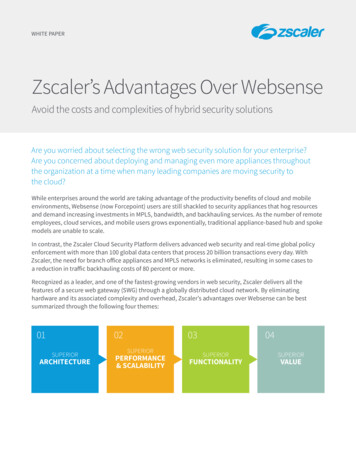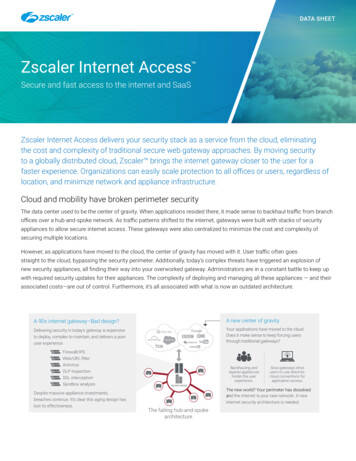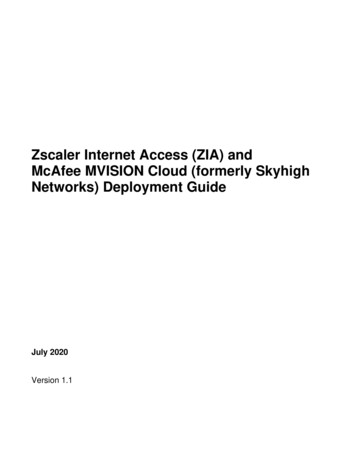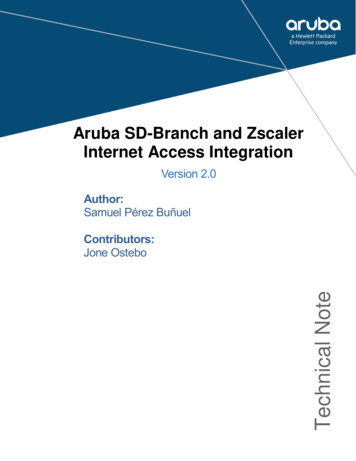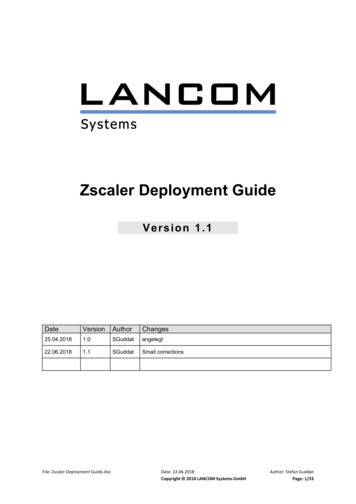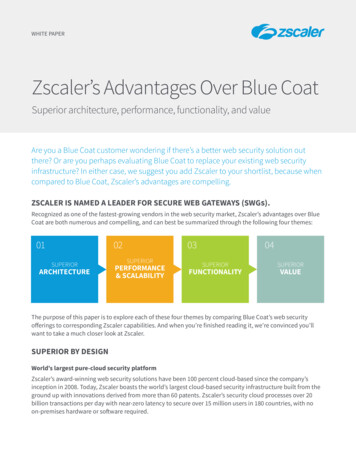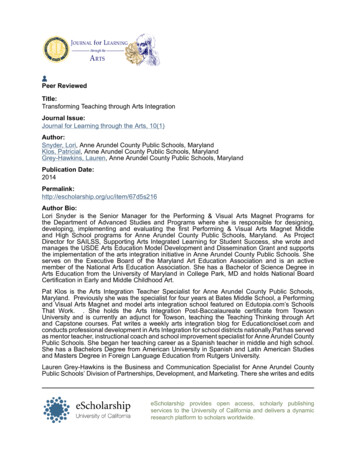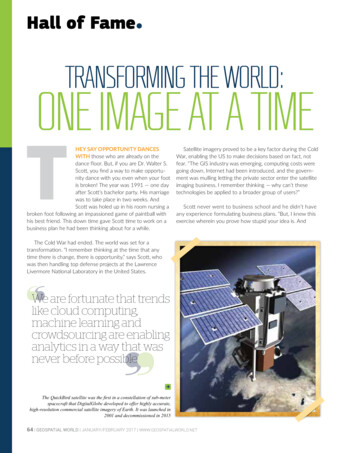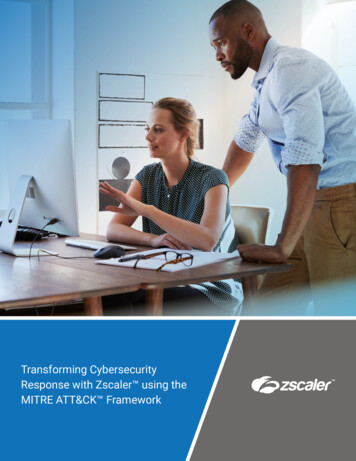
Transcription
Transforming CybersecurityResponse with Zscaler using theMITRE ATT&CK Framework
ZSCALER TECHNICAL WHITEPAPERTable of contentsIntroduction 4What is MITRE ATT&CK? 4How can an enterprise benefit from ATT&CK?4What is the difference between ATT&CK and Lockheed Martin Cyber Kill Chain?4What is the ATT&CK Model? 5The MITRE ATT&CK Framework: Matrix for Enterprise5Tactics 5Techniques 6Sub-techniques 6Procedure 6How customers can use Zscaler with ATT&CK6Zscaler’s unique cloud-native multitenant architecture6ATT&CK tactics & Zscaler-recommended security engines7Enterprise Matrix 7Initial access 8Execution 8Persistence 10Privilege escalation 12Defense evasion 14Credential access 16Discovery 17Lateral movement 19Collection 19Command and control 20Exfiltration22Impact 22Conclusion 24 2021 Zscaler, Inc. All rights reserved.2
ZSCALER TECHNICAL WHITEPAPERTable of contentsAppendix A - Zscaler Security Engines and Recommended Policy24Advanced threat protection (ATP) 24Browser control 24Data loss prevention (DLP) 24Cloud firewall25Intrusion prevention system (IPS) control 25Malware protection 25Sandbox 25SSL inspection 25URL filteringAppendix B - Real-World Attacks and ATT&CK Techniques Mapping2626APT33 (Advanced Persistent Threat) 26WannaCry ransomware 29Appendix C - Zscaler ZIA Security Engine’s Real-World Detection ofMITRE ATT&AC TTPs311 - ZIA engine detection of hooking, credential from web browser,process injection, and registry run keys/startup folder techniquesbeing used in an attack.312 - ZIA engine detection of data destruction technique being used in an attack.333 - ZIA engine detection of PowerShell and install root certificatetechniques being used in an attack.344 - ZIA engine detection of uncommonly used port and data destructiontechniques being used in an attack.35Appendix D - Zscaler security research materials detailing attacktechniques and MITRE ATT&CK mapping examples36LinkedIn Job Seeker Phishing Campaign Spreads Agent Tesla36PurpleWave—A New Infostealer from Russia 36Malware Leveraging XML-RPC Vulnerability to Exploit WordPress Sites 2021 Zscaler, Inc. All rights reserved.373
ZSCALER TECHNICAL WHITEPAPERIntroductionDefending an enterprise network against modern-day attacks remains an increasingly difficult challenge thatrequires, among other things, advanced technologies and innovative approaches for thwarting an adversary’sgoals. Because new and complex attacks are continuously created, there is a need for a common frameworkto understand how attackers operate to achieve their objectives. This framework should not only help inunderstanding the attack but also to understand existing defenses and what mitigations can be put in place tothwart attacks.What is MITRE ATT&CK?To help address the challenges of defending against modern attacks, MITRE Corporation developed a processfor modeling an adversary’s post-compromise behavior at a granular level with a common taxonomy. Thismodel is named the ATT&CK (Adversarial Tactics, Techniques, and Common Knowledge) framework, andit serves as a knowledge base of commonly observed adversarial behaviors to support the efforts of threatintelligence functions, with adversary emulation and defensive gap analysis.ATT&CK was created out of the need to systematically document and catalog adversaries’ behaviors basedon millions of data points observed from real-life attacks and breaches. The model describes the Tactics,Techniques, and Procedures (TTPs) of adversarial behavior and breaks them into categories based onthe sequence of steps involved in an attack. It is not intended to be exhaustive and is very much a livingframework that is continuously updated as new TTPs are discovered.How can an enterprise benefit from ATT&CK?The goal of ATT&CK is to break down, classify, and document adversarial behaviors from previously observedattacks in a common language that is consistent and clear. This type of cataloging and identification providesa number of benefits, such as the following use cases: Adversary emulation: Test and verify defenses against common techniques of adversaries. Red team: Create plans and organize operations to avoid certain defensive measures that may be in placewithin a network. Evaluate current defenses: Assess tools, monitoring, and mitigation capabilities of existing defenses withinan organization’s environment. Finding gaps in coverage: Identify gaps as a way to prioritize investments for security improvements.Similar security products can also be compared against a common adversarial behavior model todetermine coverage. Prioritize detections: Identify and rank alerts based on their potential threat level.What is the difference between ATT&CK and the Lockheed Martin Cyber KillChain framework?ATT&CK and Lockheed Martin’s Cyber Kill Chain resemble each other in that both are models that define thesteps attackers use to achieve their goals. ATT&CK sits at a lower level of definition to describe adversarialbehavior than the Cyber Kill Chain. ATT&CK tactics are unordered and may not all occur in a single intrusionbecause adversaries’ tactical goals change throughout an operation, whereas the Cyber Kill Chain usesordered phases to describe high-level adversarial objectives. 2021 Zscaler, Inc. All rights reserved.4
ZSCALER TECHNICAL WHITEPAPERWhat is the ATT&CK model?The ATT&CK model is an ordered list of observed behaviors from known attacks. These behaviors are knownas tactics and techniques.ATT&CK is visually organized into a few different matrices: PRE-ATT&CK, Enterprise, and Mobile. Each ofthese matrices contains various tactics and techniques relevant to its domain.PRE-ATT&CK is a matrix of tactics and techniques related to what attackers do before they try to exploita particular target network or system. The Enterprise matrix contains tactics and techniques that apply toWindows, Linux, and/or MacOS systems. Mobile matrix contains tactics and techniques that apply tomobile devices.The scope of this paper is limited to the Enterprise Matrix.The MITRE ATT&CK Framework: Matrix for EnterpriseThe MITRE ATT&CK framework Enterprise Matrix is composed of 14 tactics, including the first twoPRE-ATT&CK tactics, each with associated techniques. The tactics appear in roughly sequential order,following the general stages of a comprehensive (read: worst-case) adversarial attack:Figure 1. The MITRE ATT&CK framework Matrix for Enterprise. Source: MITRE Corporation.TacticsTactics represent the “why” of an ATT&CK technique. It is the adversary’s tactical objective for performing anaction. Tactics serve as useful contextual categories for individual techniques and cover standard notationsfor things adversaries do during an operation, such as persist, discover information, move laterally, executefiles, and exfiltrate data. There are 12 tactics that have been observed from previous attacks and are definedin the ATT&CK matrix. 2021 Zscaler, Inc. All rights reserved.5
ZSCALER TECHNICAL WHITEPAPERTechniquesTechniques represent “how” an adversary achieves a tactical objective by performing an action. Techniquesmay also represent “what” an adversary gains by performing an action. For example, an adversary may dumpcredentials from an operating system to gain access to useful credentials within a network. There may bemany ways, or techniques, to achieve tactical objectives, so there are multiple techniques in eachtactic category.Sub-techniquesSub-techniques describe “how” an adversary achieves a tactical objective in more detail, including the specifictools used. For example, an adversary may use spear-phishing as a targeted phishing attack to make thephishing technique look more genuine.ProcedureProcedure details the steps an adversary takes to achieve a goal, including specific tools, methods, andoperating systems used.How customers can use Zscaler with ATT&CKThe Zscaler Internet Access (ZIA ) solution can be directly mapped to mitigations for various ATT&CKtechniques. Leveraging ZIA engines, such as the Advanced Cloud Firewall, Advanced Threat Protection,Malware Protection, CASB, DLP, Advanced Cloud Sandbox, and others, ZIA has a multitude of mechanismsavailable to not only detect documented ATT&CK techniques, but also defend against them.Additionally, Zscaler integrates with endpoint detection and response (EDR) vendors to complement theirsolutions and provide protections against adversarial tactics and techniques that are endpoint-specific or thatare insider attacks or laterally moving threats.Zscaler’s unique cloud-native multitenant architectureZIA is a secure internet and web gateway delivered as a service from the cloud. ZIA is a truly distributedmultitenant, custom-built TCP forward-proxy architecture that is cloud-native, making it highly scalable toallow for full content inspection with SSL decryption. The Zscaler Zero Trust Exchange , the platform onwhich all Zscaler services are delivered, processes more than 150 billion requests per day at peak periods andreceives 175,000 unique threat updates daily.The complete Zscaler platform is expertly positioned to disrupt the kill chain in several areas.Its layered approach helps stop inbound threats from reputation-based blocking all the way down to advancedbehavioral analysis. An integrated approach helps provide full threat context and visibility. It’s important tonote that customers looking for this level of inspection from other vendors would have to piece togetherseveral solutions.For outbound protection, Zscaler can deliver complete protection from botnet callbacks and maliciousoutbound activity, which helps disrupt data exfiltration and malware attempting to persist within the network. 2021 Zscaler, Inc. All rights reserved.6
ZSCALER TECHNICAL WHITEPAPERFigure 2. How ZIA security engines align with the MITRE ATT&CK framework tactics.The MITRE ATT&CK-relevant Zscaler security services include Advanced Threat Protection (ATP), BrowserControl capabilities, Data Loss Prevention (DLP), File Type Control, Cloud Firewall, Intrusion Prevention System(IPS), Malware Protection, Cloud Sandbox, SSL Inspection, and URL Filtering.ATT&CK Tactics & Zscaler-Recommended Security EnginesBelow are descriptions of each of the MITRE ATT&CK Enterprise Matrix tactics and our mapping ofTTPs (Tactics, Techniques, and Procedures) to Zscaler engines that can detect and mitigate theassociated techniques.Note: Zscaler engine detection of these TTPs is limited to malicious traffic, which includes payloads passingthrough ZIA cloud security. Since attackers have a multitude of mechanisms available to compromise anendpoint, such as when it’s outside the corporate network or in the case of hardware additions, and more,we strongly recommend an endpoint detection and response (EDR) solution to complement and provideadditional protections against adversarial tactics and techniques that are endpoint-specific, as well asprevention of insider attacks and lateral movement of threats. Zscaler integrates with EDR vendors throughAPI support.Enterprise MatrixThe Enterprise Matrix is defined with 12 tactics (initial access, execution, persistence, privilege escalation,defense evasion, credential access, discovery, lateral movement, collection, command and control, exfiltration,and impact) and more than 250 techniques and sub-techniques categorized by the tactic the adversary istrying to achieve. 2021 Zscaler, Inc. All rights reserved.7
ZSCALER TECHNICAL WHITEPAPERInitial accessInitial access tactics consist of various techniques an adversary might use to gain an initial foothold in yournetwork. Techniques include targeted spear-phishing and drive-by compromise.Example: One technique used by APT19 is a drive-by compromise. A drive-by compromise occurs when anadversary gains access to a system through a user visiting a website over the normal course of browsing.Attackers executed a watering-hole attack in 2014 to lure targets to a site they were known to visit—forbes.com—and performed drive-by compromises on those targets.Spear-phishing web email is another example of a technique used by attackers. While the spear-phishing webemail itself may not be blocked by ZIA engines, any phishing/malicious link or attachment embedded withinthe web email will be blocked, thereby blocking the attacker’s ability to compromise the end-user system.Figure 3. Initial access tactics, ZIA security engine detection, and recommended actions.Zscaler-recommended security engines to protect against initial access techniques: Apply Advanced Threat Protection to protect against phishing attempts, malicious active content and sites,cross-site scripting (XSS), proxy anonymizers, and peer-to-peer (P2P) file sharing. Configure Malware Protection policy to protect against malware, viruses, spyware, and users clicking on a“malicious link” or downloading a “malicious file” from the internet. Configure Browser Control policy to reduce risk of older and/or vulnerable browsers being exploited fordrive-by compromise attacks. Implement Sandbox to shield against zero-day and any unknown threats.See Appendix A for details on Zscaler security engines and recommended policy configuration.ExecutionExecution tactics consist of techniques that result in adversary-controlled code running on a local or remotesystem. This technique is often paired with other techniques such as network discovery or remotesystem discovery.Example: APT41 leveraged PowerShell to deploy malware families in victims’ environments. PowerShell is apowerful interactive command-line interface and scripting environment included in the Windows operatingsystem. Adversaries can use PowerShell to perform a number of actions, including discovery of informationand execution of code. 2021 Zscaler, Inc. All rights reserved.8
ZSCALER TECHNICAL WHITEPAPERWhile techniques such as command-line interface, PowerShell, service execution, user execution, etc., aretypically executed in an end-user system locally and is detected by endpoint security, these techniques canalso be detected by ZIA engines when an attacker’s suspicious code is run within a virtual environment thatmimics end-user system and behavior. Since ZIA inspects the traffic inline and has the ability to quarantine thesuspicious file while it’s being analyzed, we can block the malicious code from reaching the user.Note: Zscaler engine detection of these TTPs is limited to malicious traffic that includes payloads passingthrough ZIA cloud security.See Appendix C for an example of ZIA engine detection when “PowerShell” is used as part of an attack.See Appendix D for more examples from Zscaler Security Research Blogs detailing Zscaler engine detectionof various attack techniques and MITRE ATT&CK Mapping.Figure 4. Execution tactics, ZIA security engine detection, and recommended actions.Zscaler-recommended security engines to protect against execution techniques: Apply Malware Protection policy to protect against malware, viruses, spyware, and users clicking on a“malicious link” or downloading a “malicious file” from the internet. Configure URL Filtering to limit enterprise risk exposure by managing user access to web content based onsite categorization. Implement Sandbox to shield against zero-day and any unknown threats.See Appendix A for details on Zscaler security engines and recommended policy configuration. 2021 Zscaler, Inc. All rights reserved.9
ZSCALER TECHNICAL WHITEPAPERPersistencePersistence tactics consist of techniques that adversaries use to keep access to systems across restarts,changed credentials, and other interruptions that could cut off their access. Techniques used for persistenceinclude any access, action, or configuration changes that let them maintain their foothold on systems, such asreplacing or hijacking legitimate code or adding startup code. More than 60 techniques are detailed underthis tactic.Example: Adversaries may use more than one remote access tool with varying command-and-controlprotocols or credentialed access to remote services so they can continue to maintain access even if anaccess mechanism is detected or mitigated. APT3 has been known to use multiple backdoors per campaign. 2021 Zscaler, Inc. All rights reserved.10
ZSCALER TECHNICAL WHITEPAPERFigure 5. Persistence tactics, ZIA security engine detection, and recommended actions.While techniques such as dylib hijacking, hidden files and directories, logon scripts, PowerShell profile, etc.,are typically executed in an end-user system locally and are detected by endpoint security, these techniquescan also be detected by ZIA engines when an attacker’s suspicious code is run within a virtual machineenvironment that mimics end-user systems and behaviors. Since ZIA inspects the traffic inline and has theability to quarantine the suspicious file while it’s being analyzed, we can capture and analyze the maliciouscode before it reaches the endpoint and blocks the malicious code from reaching the user.Note: Zscaler engine detection of these TTPs is limited to malicious traffic that includes payloads passingthrough ZIA cloud security.See Appendix C for an example of ZIA engine detection when “hooking” and “registry run keys/startup folder”techniques are used as part of an attack.Zscaler-recommended steps to protect against persistence techniques: Configure a Sandbox policy to detect and block malicious code before delivery to endpoint. Employ EDR endpoint security to complement protection against adversarial persistence techniques.See Appendix A for details on Zscaler security engines and recommended policy configuration. 2021 Zscaler, Inc. All rights reserved.11
ZSCALER TECHNICAL WHITEPAPERPrivilege escalationPrivilege escalation tactics consist of techniques used by adversaries to gain higher-level permissions ona system or network. Adversaries often enter and explore a network with unprivileged access, but look forways, such as system weaknesses, misconfigurations, and vulnerabilities, to elevate their privilege to a highersystem or admin-level permissions to follow through on their objectives.Example: APT28 has used CVE-2015-1701 to access the SYSTEM token and copy it into the current processas part of privilege escalation. 2021 Zscaler, Inc. All rights reserved.12
ZSCALER TECHNICAL WHITEPAPERFigure 6. Privilege escalation tactics, ZIA security engine detection, and recommended actions.While techniques such as access token manipulation, hooking, path interception, etc., are typically executed inan end-user system locally and detected by endpoint security, these techniques can also be detected by ZIAengines when an attacker’s suspicious code is run within a virtual machine environment that mimics end-usersystems and behaviors. Since ZIA inspects the traffic inline and has the ability to quarantine the suspicious filewhile it’s being analyzed, we can capture and analyze the malicious code before it reaches the endpoint andblocks the malicious code from reaching the user.Note: Zscaler engine detection of these TTPs is limited to malicious traffic that includes payloads passingthrough ZIA cloud security.See Appendix C for an example of ZIA engine detection when “hooking” or “process injection” techniques areused as part of an attack.Zscaler-recommended steps to protect against privilege escalation techniques: Configure a Sandbox policy to detect and block malicious code before delivery to an endpoint. Employ EDR endpoint security to complement protection against adversarial privilegeescalation techniques.See Appendix A for details on Zscaler security engines and recommended policy configuration. 2021 Zscaler, Inc. All rights reserved.13
ZSCALER TECHNICAL WHITEP
(IPS), Malware Protection, Cloud Sandbox, SSL Inspection, and URL Filtering. ATT&CK Tactics & Zscaler-Recommended Security Engines Below are descriptions of each of the MITRE ATT&CK Enterprise Matrix tactics and our mapping of TTPs (Tactics, Techniques, and Procedures) to Zscaler engines that can detect and mitigate the associated techniques.
